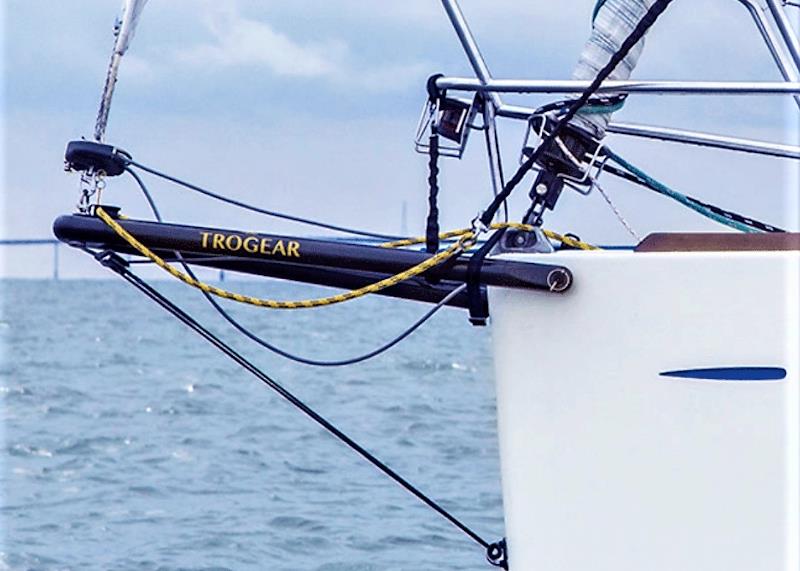
How do I rig the bobstay of my Trogear bowsprit?
by Kerri Robson 20 Mar 2019 01:00 PDT

How do I rig the bobstay of my Trogear bowsprit? © Trogear
The popularity of flying a code zero or asymmetric sail increased tenfold in 2018, with the trend set to soar in 2019 as more and more sailors take advantage of these high performance sails.
Faster and more manageable, these sails sit forward of the forestay, requiring an attachment for the furling drum in front of the bow, known as a bowsprit.
Whilst most modern, performance cruising boats will have a permanent bowsprit, older boats will be required to retrofit a bowsprit in order to enjoy the use of a code zero or asymmetric.
In our previous Trogear blog, we explained how the Trogear removable bowsprit could help you do just that; developed in 2012 by Henry Dokonal, the bowsprit combines minimum weight with maximum strength and is ideal for shorthanded sailing.
But if you've already purchased your Trogear bowsprit and are ready to reap the benefits how on earth do you rig the bobstay?!
The purpose of a bobstay is to counteract the upward tension on the bowsprit, caused by the flying sails and the torsional stay.
The bobstay is connected to the tip of the bowsprit and routed to a u-bolt, which is attached on the bow. Assuming the sails are deployed and the bowsprit is horizontal, the bobstay should achieve an angle of 45 degrees or more, to provide enough downward force to counteract the loaded sail.
The following instructions illustrate how to assemble a common bobstay set up for the Trogear Bowsprit:
First, here's a diagram:
Short Dyneema® Strop
- This acts as a link and transfers the tack load of the sail directly to the bobstay
- This means the bowsprit is only ever taking the compression load
- The upper end of the strop should be a stainless ring to quickly, easily attach the furling drum
- The lower end of the strop goes onto a low friction ring which forms part of the bobstay 2:1 purchase
- This strop should be as short as possible
Bobstay 2:1
- It should be made of single braid Dyneema® line (SK78) correctly sized for the bowsprit
- This 2:1 purchase system is dead-ended at the low friction ring, under the tip of the bobstay, and then runs down to the u-bolt
- The Dyneema® can run directly through the u-bolt or you can add a small block or a thimble to reduce friction
- From the u-bolt the Dyneema® runs back up through the low friction ring and back towards the bow
- This 2:1 Dyneema® bobstay section only needs to be as long as necessary to allow the bowsprit to be in the fully raised position
- This line can be finished in a small eye-splice
Control Line
- Either splice or tie a suitably sized, low stretch double braid Dyneema® line to the end of the bobstay and lead this line back through a clutch to a winch
Bowsprit Height Control
- One of the big advantages of the Trogear bowsprit is that it hinges vertically to make attachment of furling sails easier, plus reducing overall boat length (and therefore berthing fees!) when not in use
- Due to this hinged movement the sprit needs a preventer to stop it dropping down below horizontal
- This can be achieved in a variety of ways using a short webbing or Dyneema® strop from the stem fitting to the bowsprit tubes either side at the bow
- In addition, a strong bungy cord can be used from the bowsprit to the pulpit to automatically raise the bowsprit when the bobstay system is eased
Line Recommendations
Based on a SK78 core, we recommend the following diameters for the single braid 2:1 bobstay section and the double braid line back to the clutch/winch:
| Trogear | 2:1 Single Braid Dia (mm) | Double braid Dia. (mm) |
|---|
| AS30 | 4 | 6 |
| AS40 | 5 | 8 |
| AS50 | 6 | 10 |
| Atlas 50 | 6 | 10 |
As the forces on the bowsprit are relatively high, the materials used must be correctly sized, installed and maintained, with checks made regularly. All materials should have a minimum safety factor of 2, and Trogear recommend rigging the bobstay in such a way that compression forces act in a straight line from the tip towards the attachment.
Haven't got your hands on a Trogear adjustable bowsprit yet? The attractive, patented design is available in four models, with custom designs possible. Shop Trogear Bowsprits here or if you have a custom enquiry complete our Custom Bowsprit Enquiry Form!